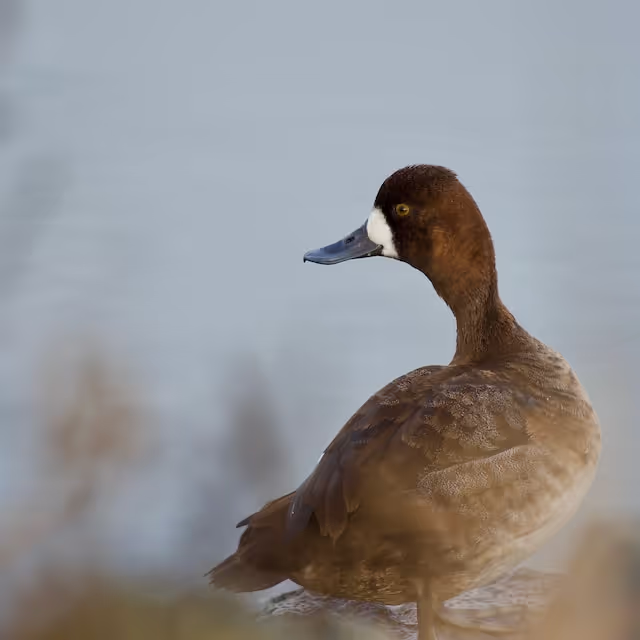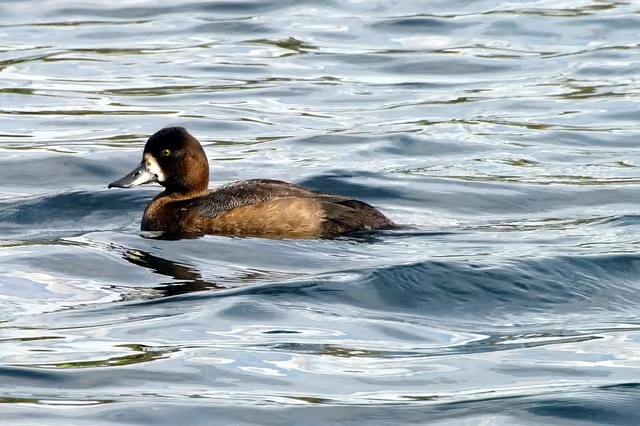The Lesser Scaup


Introduction
In a recent post, we introduced you to the Greater Scaup, which is one of the many bird species you can find here in our little piece of coastal paradise during the winter months. But did you know that there is also a Lesser Scaup that also spends the winter here? Today, we are going to shine a spotlight on the Lesser Scaup, which, despite its name, is just as magnificent as the Greater Scaup.

Image by gayleenfroese2 from Pixabay
Size and Shape
Lesser Scaups (scientific name: Aythya affinis) have small peaks at the back of their heads. The rest of their heads and necks are flat, giving them a smooth and stylish appearance (1). They are about the same size as crows, with a wingspan of 26.8 to 30.7 inches (68 to 78 centimeters). They are 15.3 to 18.1 inches long (39 to 46 centimeters) and weigh anywhere from 16 to 38.4 ounces (454 to 1,089 grams) (1).
Colors and Patterns
From a distance, you might think that breeding male Lesser Scaups sport an exclusively black and white color scheme. However, upon closer examination, you will notice that they have an iridescent sheen on their head (1). This sheen can range in color from purple to green. They also have a bluish-colored bill, a yellow eye, and a “finely barred” back that sports the black and white color scheme (1).
The female Lesser Scaups’ color scheme is mostly a beautiful shade of brown. Their heads generally feature a darker shade of brown than the rest of their bodies. Some female Lesser Scaups also have a white patch next to their bill (1).
Nonbreeding males have blackish heads and mottled gray and brown bodies. This gives them the appearance of being a cross between a female and a breeding male (1).
Habitat
For most of the year, Lesser Scaups establish large flocks. The flocks tend to be tight-knit (2), meaning that they tend to stick together. However, the flocks are not just limited to Lesser Scaups. They often include other diving ducks, such as Redheads and Canvasbacks (1). The flocks take up residence on coastal bays, in estuaries, and in reservoirs. They will also establish winter homes on lakes, with inland lakes being preferred (1).
During the breeding season, Lesser Scaups tend to prefer living in marshland areas in prairie and forested regions (1), where they can safely nest away from most predators.
Range
Lesser Scaups are one of the most widespread diving ducks in North America (3). The territory that they can be found in is quite expansive when compared to many of the other bird species we have discussed on this blog before, encompassing the entire Lower 48 states, almost all of Canada (the far northern parts of the country being the only areas they aren’t known to occupy), Eastern Alaska, Central America, the Caribbean, and Mexico (3). However, the territory does change with the seasons. For example, here on the Pacific Coast, the Lesser Scaup is primarily seen only during the winter months. But in Eastern Washington, they are common sight throughout the entire year (3). In Alaska and most of Canada, they are usually only seen during the breeding season (3). Some areas of the Lower 48 states, including most of the Great Lakes region, only get to see the Lesser Scaup during their twice annual migration periods (3).
Diet and Feeding Behavior
The majority of the Lesser Scaup’s diet consists of mollusks and plant material. Mollusks are a particular favorite, with clams and snails being at the top of the menu (3). Aquatic insects and crustaceans are also favored animal matter meal choices for Lesser Scaups (3). In the Great Lakes region, invasive Zebra Mussels are another delicacy that Lesser Scaups often devour in large quantities (3).
When it comes to plant material, Lesser Scaups will eat a variety of different things, including wild celery, pondweeds, and the leaves and stems of sea lettuce (3). They will also consume various seeds, including those of sedges and grasses (3).
Lesser Scaups forage for their food. They primarily do this by diving and swimming underwater. However, they will occasionally dabble or up-end in shallow water (3). While Lesser Scaups usually feed during daytime hours, some will occasionally go looking for food during the night (3).
Courtship and Nesting
It is believed that Lesser Scaups primarily begin to breed starting at the age of two (3). Males will put on elaborate displays to try to attract females. These displays can include shaking their heads, throwing their heads back and bringing them forward again at a rapid pace, and amplified bowing movements (3). While most of these displays are performed on land, some Lesser Scaups will perform underwater as well (3).
Once a bonded pair is formed, a nest site is chosen. The site is normally on dry land that is located close to a body of water and surrounded by vegetation (3). Islands in lakes are desired locations, as are stands of bulrush that are located in marshlands. The nest is a shallow depression with some dry grass and down (3). These help to make it warm and comfortable.
Eggs and the Young
Lesser Scaups can lay anywhere from eight to fourteen eggs. The eggs are olive-buff in color. The incubation process is handled exclusively by the female, and runs for three to four weeks (3).
Once they hatch, the young are quick to begin their lives. As soon as their down dries, they immediately go underwater. They are generally too light to stay down for long (2). However, after about five to seven weeks, they are normally able to dive for up to twenty-five seconds. They can also swim up to sixty feet underwater by this time (2).
The young are tended to by female Lesser Scaups, who will sometimes combine broods and jointly care for all of the young. The young are responsible for feeding themselves. They make their first flights approximately 1.5-2 months after hatching (3).
References
© Ian Caldwell, August 2023
Touch whale bones, examine shipwreck artifacts and connect with the coast's living history.

Support our mission, get involved in educational programs, or contribute through donations and volunteering.